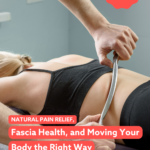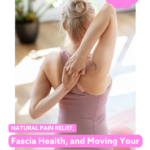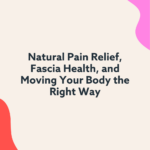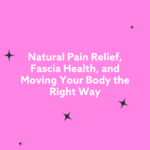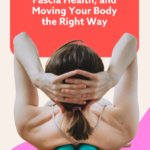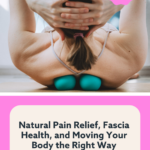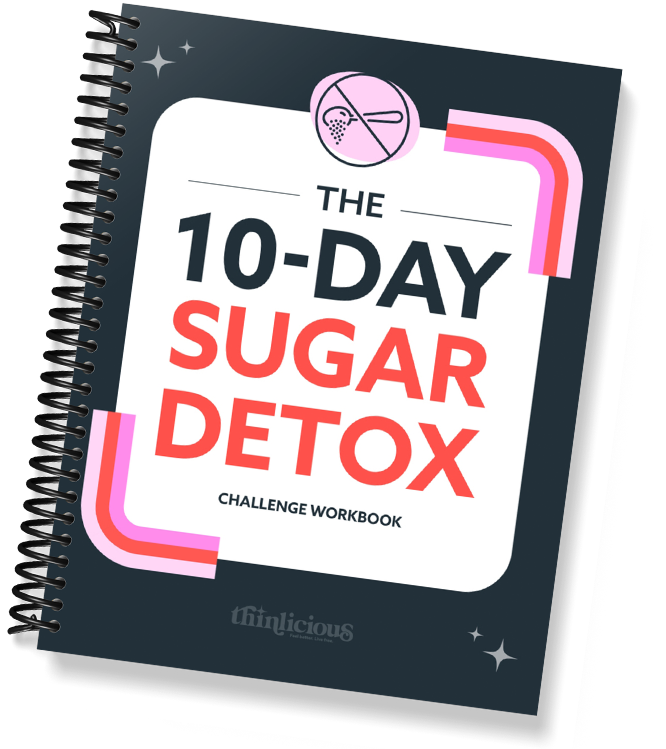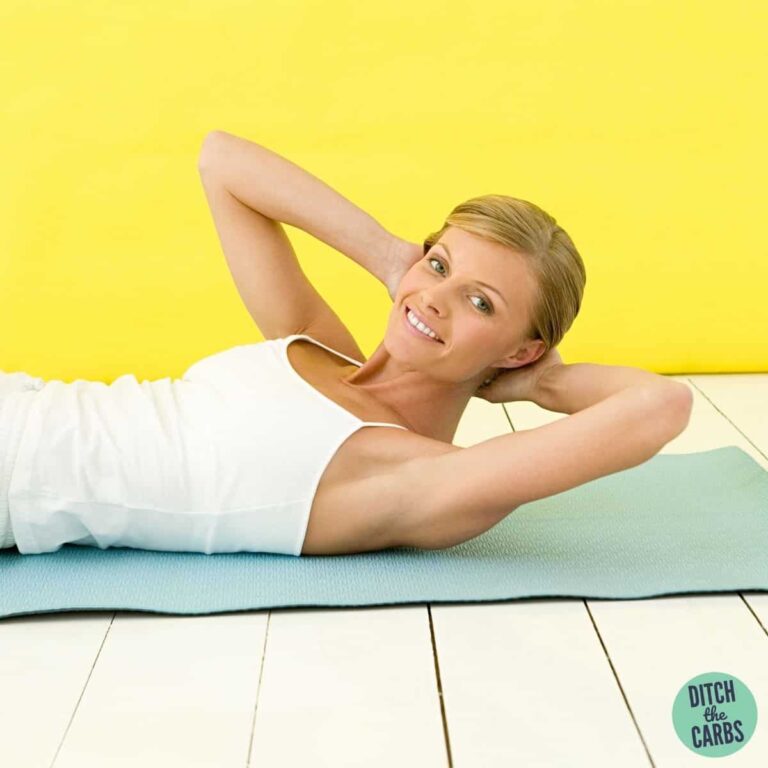Have you ever just wished you could feel better? Sure, it would be great to lose a little weight or look good in your skinny jeans but what you really want is to just make your body feel good again. No more sore muscles or aches and pains, no more digestive issues, no more bloating or gas.
Well what if I told you it could be possible to have all of that without even changing the way that you eat?
Do I have your attention yet? Good, because I’m telling you right now, you are going to love this interview with my guest, Anna Rae. She is a world renowned movement expert who specializes in fascia, a system in the body that is so incredibly important and yet somehow never really gets talked about.
What she has to share is so interesting and so practical and so relevant to every single one of us. I can’t wait for you to dig into this fascinating interview.
Are you ready to lose weight and heal your body for life (without dieting, drugs, or making yourself miserable)?

Our free on-demand video training will walk you through how to make this THE year you set health goals…and keep them.
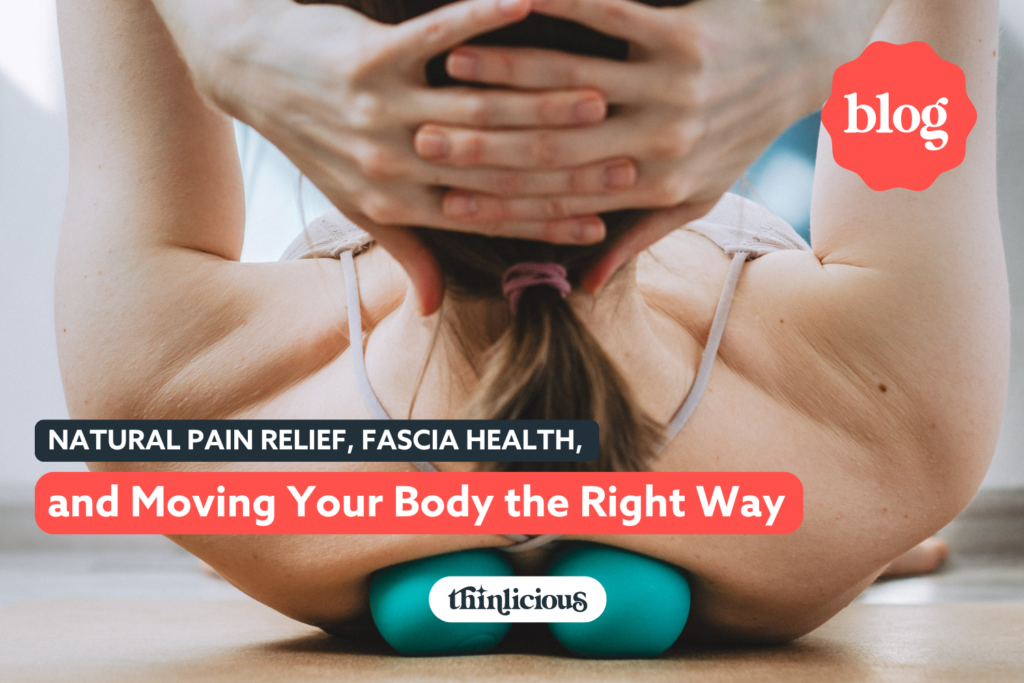
But first, I’m Ruth Sukoup and here at Thinlicious.com we talk about everything from the science of weight loss to practical tips for making your health a priority in the midst of a busy life. In this post, we are going to hear from Anna Rae, who is a fascia expert and the founder of GST Body about how changing your approach to movement can completely transform your health.
Let’s dive in!
Ruth: Anna, thank you so much for being here, why don’t we start with a little bit about you, who you are, what you do, how you got to be doing what you are now, because your job is pretty fascinating.
Anna: Thanks. Yeah, it’s been a long journey. I tell people how long I’ve been doing this and they’re like, “you’re not that old.” I’m like, “well, I started when I was 18.” That was kind of a rarity for someone to find their trajectory that young, but my name is Anna and I run a company that’s dedicated to health and wellness, specifically through the lens of fascia.
It’s a long story, but I’m going to make it short for you. At 18, I was living in San Francisco and I was living in a body that felt like it was 80. And that’s not a hyperbole. I literally felt achy and in so much pain all the time. I had multiple symptoms, like gastrointestinal issues.
I was having respiratory problems. I was trying to be a professional dancer at the time. I had been certified in three different Pilates, two different yogas. From the outside, I looked extremely healthy. Very vital. And I was so young, right? So what’s wrong with me?
I would go to every professional and they were unable to give me any diagnosis. They didn’t know. My MRIs came back fine. My CAT scans came back fine. My stool tests were all fine. And I’m like, “but there is something definitely wrong with me.” And some of the symptoms were, you know, like when you work out really hard, and you can’t take your shirt off of your head afterwards or it’s hard to sit down on the toilet.
I would feel like that no matter if I did a workout or not. It just was like this excruciating pain in my muscular skeletal system.
And then I had digestive issues that they gave me a catch all diagnosis of IBS for, but I had the inability to sleep. I’d have bubbles in my stomach.
It made me kind of insomniatic. But I think the scariest symptom was just that I, well, I like to run through Golden Gate Park. I like to jog. I didn’t do it professionally or anything, but I was pretty good at it. I was a good runner. And one day I would go up the Hills and I’d feel like a well trained marathon runner.
And two days later I would do the exact same run and feel like a 10 pack a day smoker. And they would give me inhalers. And the doctors said, “we don’t understand what’s going on. You don’t have asthma.”
So I had taken enough anatomy that I was like, this isn’t muscular, even though it feels like I’m achy all the time.
This isn’t really skeletal. So what else is there? And I had taken a workshop in my training at the Boulder Pilates Center on fascia. The workshop was really on emotional imprinting into fascia and trauma and how you read the body. It wasn’t even a medicinal kind of workshop, but I was like, “I wonder if what I’m going through is fascia?”
And 25 years later, it turns out that yes, indeed, the reason that my symptoms were so varied and so vast is that it was a connective tissue system problem and I worked for 25 years to find techniques. Because what was happening also is that in the early days, fascia was really the focus of manual therapies, and I would go and do Rolfing or Heller work and do all of these things, but then my symptoms would always flare back up when I was active and doing my dance and doing my workouts.
And I’m like, what’s going on between these two, or what’s the underlying symptom? And what I was realizing is that a lot of the things that we’re taught about movement and about how we use our bodies is actually damaging to the connective tissue system. It’s almost like how we know that sun rays create sun cancer now because of the high frequency of UVA and UVB.
Rays that come into your skin and fascia have a very similar kind of response. fascia is like the skin underneath your skin. It’s all of this tissue that lays under the surface where the sun doesn’t shine. So there’s these things that fascia hates and that creates a lot of problems. And it’s really significant to our health because fascia is not just in your muscular skeletal system, it’s everywhere inside of you and it wraps your organs and it layers into your endocrine system, it affects your nervous system, all of these things that it creeps into and so it’s really a whole body system that has whole body implications on your health.

Ruth: Wow. So you’ve been dealing with this. So were you able to fix it when you started looking into it? Like how long has it been fixed for you?
Anna: That’s a great question. So I try to tell people that it was literally a 25 year journey and because there wasn’t any information out there on this, it wasn’t a quick fix.
I was desperate. I literally studied everything. I would go to this workshop and I’d get a flare up and I’m like, why did this flare me up? Why did this not? And I had a Pilates studio in San Francisco also at the time so I started testing my techniques out on other people.
And I’m like, “Oh, when they come in and they have nerve damage down their arms and I do this, it’s not prescribed by PT. It’s actually the opposite of what physical therapy wants you to do. They get better and they avoid their surgery.” And things like that came to the surface.
And so how did I fix myself? I just did it for 25 years of trial and error. Does it take that long to do it? No, but I think that because it wasn’t available and because my issues were genetic and, you know, they were influenced by what I did. I was a dancer.
It’s almost like there’s junk moves just the way that there’s junk food. And fascia’s number one influencer is load. It’s called stress or load, mechanical load. And so it’s literally like the movements that we do are junk food for your fascia and it creates a huge problem in our entire physiology, all the way from cells to tissues, to organs, into the whole body system.
Things like how we treat our core messes up more digestion and affects metabolism more than anything. Hormone distribution, because fascia is integrated in all of those processes, everything.
Ruth: Okay. This is like mind blowing right now because nobody talks about this, right? Like no one talks about this.
There is this one time I remember getting a massage, maybe 20 years ago. And the massage therapist was like, “I’m going to do this thing where I’m…” and she used that word fascia. She’s like, “I’m going to move your fascia around.” And it was like the most amazing experience I’ve ever had with getting a massage before. I could feel it.
And I felt so good. I’ve never felt so good. And then she stopped doing massages. I moved to a different state. I never got to see her again. Never again, and I have been getting massages for 20 years since. And every time I mention it to somebody when getting a massage, they’ve never heard it before.
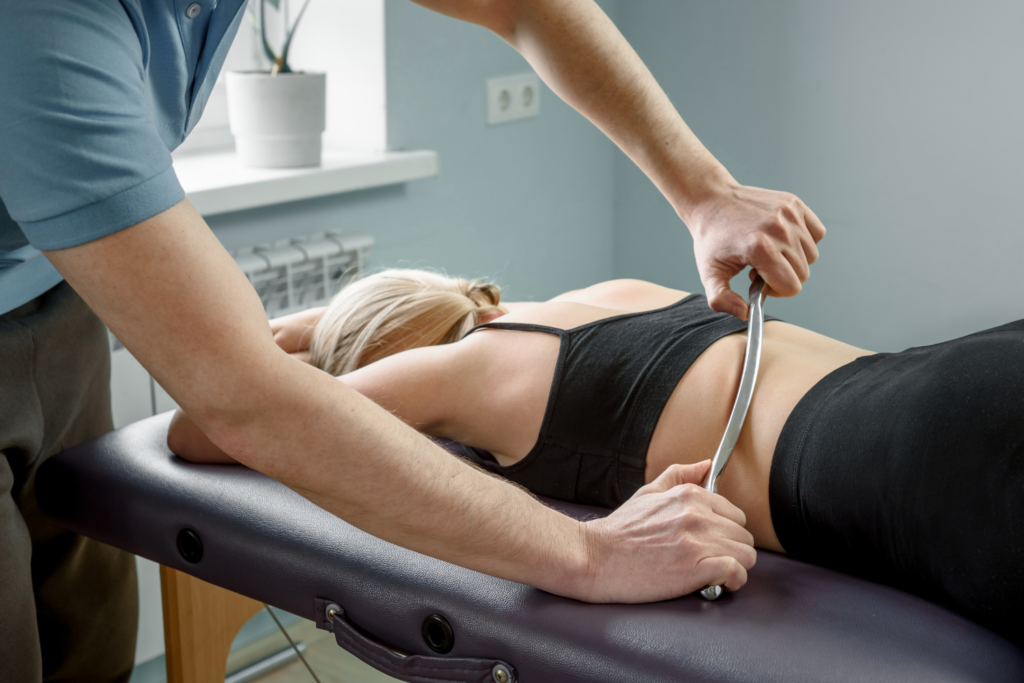
If this is such a huge thing, I mean, I talk a lot about health and wellness and eating right. And food and how all of our systems are connected and there’s stuff like this. It’s pretty basic knowledge that nobody’s talking about in terms of food, right? Why is this not just common knowledge? Explain that to me.
Anna: Great question. I mean, that’s a big, big thing to chew on. But let me just say this, I feel like one of the reasons is that most of our approach to health and wellness comes from traditional medicine and it never really cared about fascia.
It would cut open cadavers and they’d see all this white stuff everywhere. But number one, fascia loses its primary consistency when you die. So by the time you open a cadaver, all that’s left is the 30 percent fiber, not the 70 percent fluid. And so all of a sudden you look inside a dead body and the fibers are all kind of dehydrated and they’re everywhere and they just would cut it away and they thought it was superfluous, like it didn’t have any meaning.
So it wasn’t until the two thousands when I think Congres started to be like, we need to actually study this stuff. Like it’s everywhere. It’s in your eyes. It’s covering your brain. It’s through your fingernails. It’s literally everywhere. So what is it? And why do we have it?
And so I think that that perspective that it was insignificant, kept it kind of hidden. And I think the other reason that it’s not well known is that we pride ourselves on specialization of medicine and being an expert in one thing.
And so our basis for treatment is always diagnosis, which is taking an aperture and saying, here are all of these symptoms and let’s narrow it, narrow it, narrow it. And we’re going to get really specialized and we’re going to only focus on this one thing. And that works for an aspect. But if you can’t open the aperture back, then all of a sudden you don’t see the integratedness of the human body.
They’re like, oh, your digestion is nothing related to your lungs. And I’m like, but they are, because I’ll have a flare up here and I’m having this and they’re totally related. And so I think that those two things kind of didn’t fit our perspectives. I think the other thing is that we see the body and we see the world very concretely in the West.
We like angles and straight ends and the like. Rigid structures, we like things to be true and right, and binary and things that can be controlled. And what life kind of shows you is that there’s not so much structure, right? That there are still methods and there’s still order, but it’s not structured.
And so it’s kind of interesting to look at how we approach our health and wellness through a very kind of myopic narrow lens rather than expanding it. And I think that fascia does this for us because it’s breaking all the rules. So fascia, like I said, is 30 percent fiber, 70 percent water, which means that we actually need to change the science that we start treating the body under instead of it being from solid, we need to look at it from a fluid body.
You’re more like a water balloon being thrown through the air than you are a stick. And so when we start looking at movement as part of the health equation, you’re like, Oh, we’re actually training our bodies to be more solid, hold a solid core, tone our muscles, bring everything and tighten and tighten.
Well, that’s what stress does. Stress tightens us. Stress completely. compresses us. So there’s this need to almost change the paradigm shift. And most people are starting to question that, right? Because our successes at treatment are not improving, right? We don’t have answers that are actually doing significant changes for people’s health.
Ruth: No, that’s for sure. People are sicker and feel worse than ever before. So how can people use this? Like if somebody’s reading this right now and they’re thinking, “Oh, there’s this fascia that I didn’t even know existed. The connective tissue in your body that’s connecting everything together. That’s 70 percent water and 30 percent fiber.” What do you do with that information? And how does that transform the way you approach your health?
Anna: So probably anyone reading this can guarantee that they probably have fascial damage. Starting at 15, we start glycation processes, which is part of the oxidative stress that happens to the body as we age.
Then we have sedentary lifestyles. And then the way we work out is constantly loading and loading and loading into our tissues. A load is just stress that’s coming in and kind of, uh, weighing down the body. So almost everybody that I know has some fascial damage if you’re over the age of 20.
It’s almost like most people have skin damage because in their twenties, they were not using sunscreen. And then at 40, they’re like, “Oh my gosh, what do I do?”
Ruth: How do you go in and heal? What does damaged fascia look like?
Anna: Well, it’s dehydrated. It looks kind of like ramen noodles, where all of these things are locked and layered and stiff and rigid. And if you think about it, I didn’t get to give my whole spiel about what fascia is and what it does in the body. But the idea is that every body system relies on its consistency. It has to be fiber and mesh, and it has to have fluid, like, almost like when you shake a sheet and then you lay it on the bed and the wave kind of travels through the sheet.
Well, every time you move in life, energy is moving through your fascia, creating this kind of wave that needs to be able to move. And if you have dehydrated ramen type noodles, it’s really restricted. And so what do we need? We need to be able to create individuation in your fibers, hydration in the tissues, and that is best done through this basic stirring in the body, movement, right?
Movement is one of the most essential ingredients, but we don’t really actually, qualify movement. In our day and age, we’re like, just count your steps. Have your watch count your steps. We do all this great analysis of diet and nutrition and elements and what’s creating inflammation and what’s creating weight gain. And what are the additives that we put in our food?
There’s been a million ways that we’ve rearranged our orientation towards food. And we don’t do it towards movement. We just think, Oh, if I just get my 45 minutes in and burn myself into the ground and burn my fat. It’s so unsophisticated. It’s so un-nuanced.
And the body’s like, you’re actually aging me. You’re pre aging me by how you’re using all of these systems that wear and tear on the body. You can actually watch it happening erosively on your joints and in your tissues. So the answer to most people is that you have to learn how to move better.
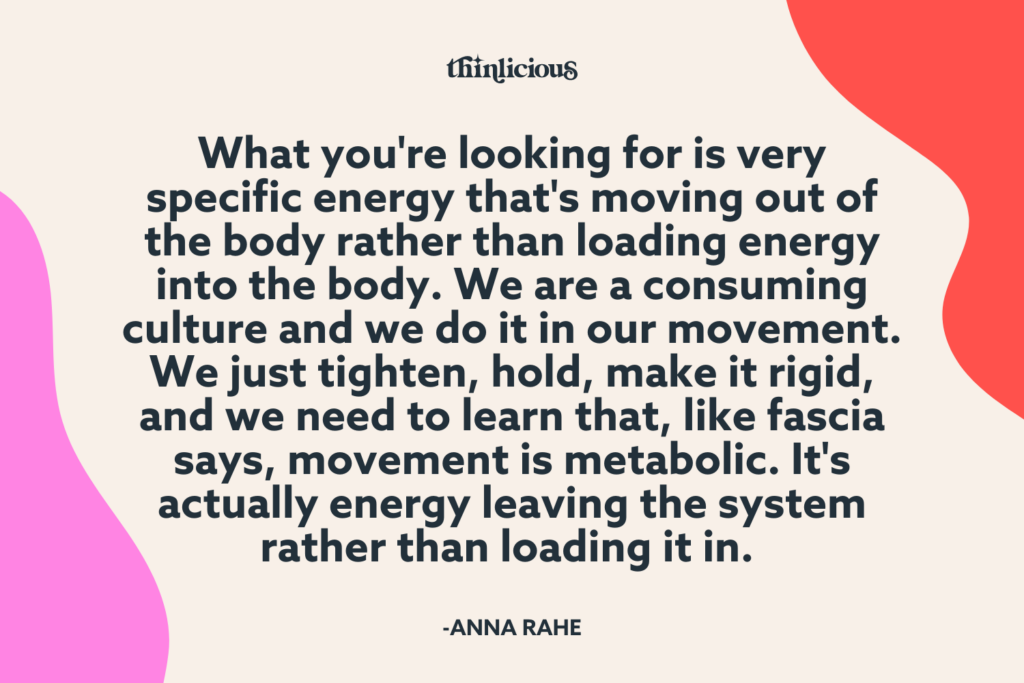
And fascia has a very specific way that it wants you to move. The first is that the fascia is like a syringe. You want to picture it like, you know, those Chinese finger toys. So when you were kids, you’d put your fingers in and the fibers loosen, you pull the fingers out and they tighten.
And this is a basic elemental movement of a syringe, which is hydraulics. And this is the movement that fascia is needing constantly. It’s called compression and traction. And each movement in our anatomy is built upon this nucleus of movement. Compression and traction. And you see it in our anthropological movement patterns.
We would squat down by the fire. We would hang from the trees. We would squat by the fire and we’d hang through the trees. But in our modern life and with our chairs, we’ve taken it and we’ve flatlined our movement. It’s just basically like, there’s no dynamics. And then we go into the gym and we just think, tighten, tighten, tighten.
Tighten, hold, pull everything in and make it, you know, like mania. So what we need to do is get back to basics and it can happen really easily throughout your day. And the other thing, what fascia really loves is to move in micro movements, micro dosing throughout your day.
So it says, don’t go to the gym. It’s almost like, don’t eat one big, super calorie meal. If someone’s like, “you get one meal a day and it has to be 2,500 calories”, you’d be like, “yeah, sure.” That’s what we do to our movement. We’re like, I got 45 minutes. Let me get all of my things in. This is not what the body wants.
Fascia is like, do 30 seconds here, do a minute 50 here, do three minutes here, go back and do this. And so you start to look at life as a jungle gym. You have to start rearranging your perspective of movement as something that needs to be layered and available in all of the things you do. So start looking around your life at fences, railings, car doors, handicap ramps, you know, structures like jungle gyms and you want to go over to a structure, put your hands on it, bend your knees and pull back like you’re hanging off of the railing.
That’s called traction. And then you want to bend your knees and you want to kind of go into a nice deep squat. And that accordion is kind of like a smush. And then you pull in your traction and you smush and you pull in your traction and all of a sudden your body and your tissues start to glide. And it’s literally like adding hot water to the ramen.
Pretty soon, those fibers will loosen. They’ll start to open. Your nerves will flow more freely. Your blood flows, your hormones will move more effectively and efficiently. Your nervous system will actually have more open communication when those fibers are open. And so what you’re looking for is very specific energy that’s moving out of the body rather than loading energy into the body.
We are a consuming culture and we do it in our movement. We just tighten, hold, make it rigid, and we need to learn that, like fascia says, movement is metabolic. It’s actually energy leaving the system rather than loading it in.
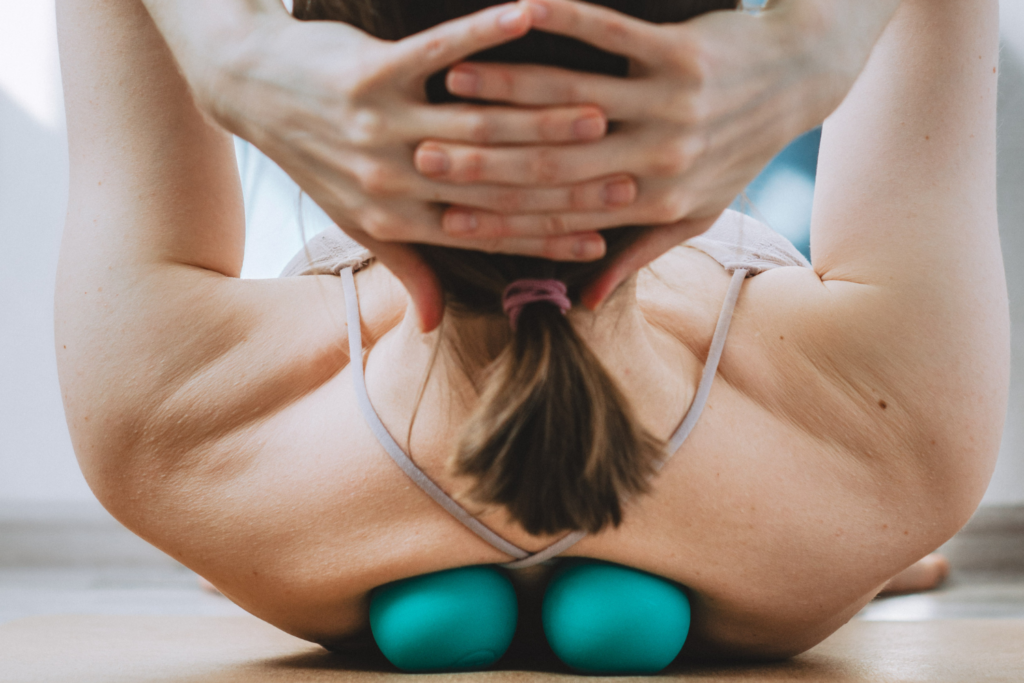
Ruth: That is so interesting and so different than basically everything that everybody talks about all the time. It almost reminds me as you were talking, we had somebody on the website a few weeks ago who was talking about Blue Zones. Are you familiar with Blue Zones, these areas where people live longer?
Anna: Yeah, they’re always moving and they’re walking up hills and they’re just, they’re moving throughout the day. They’re in the garden, probably squatting down. Right? Like they’re lifting things over their head. Like everything is very natural and we don’t get that anymore. But even the picture of turning everything you do into a jungle gym and grabbing the railing and grabbing this. Like you don’t think about that ever.
Ruth: I think about how much I just sit at my desk all day long and where it could be standing up.
Anna: Try this, put your hands on your desk and roll your chair back and try to pull yourself off your desk. Pull, pull, pull, drop your chest. Drop it to your chest. Go drop your chest forward. You could do that for 30 seconds.
And do you know what that does? That loosens your lungs inside your rib cage. It exfoliates your organs. The vitality of fascia moves life through you, it’s your primary energetic system, and if you have it alive, it’s like, when you go into a coral reef. If you’ve ever scuba dived and you watch the waves and all of these, like, seaweeds are dancing this way and the sea anemones are popping out of their tubes and then they come back in and this is literally your body. It’s more tubes than sticks and because your body’s more water, what happens to water when it sits?
It becomes static and it becomes septic and it creates disease and they are tying unhealthy fascia to cancer, the metastasis of cancer. They’re tying it with links to autoimmune deficiencies and diseases. And they’re saying, it’s the primary responder of inflammation in the body and responses to your cortisol levels directly affects the contractile nature.
And so you start looking and you’re like, literally fascia is asking us to do a 180 degree turn, 100 percent opposite of what we’ve always been taught. And what’s exciting is it can either be scary or it could be like, “Oh my gosh!”
I mean, most of the clients who come to me have been like, “I’ve tried everything. I have tried everything.” And I’m like, I see you. I see you. Cause I did too. And it’s nice. It’s like this hope moment where you’re like, there’s something that you can do that’s so different. And if you do something different, you’ll get different results.
It’s just that we keep being told to do the same thing over and over and over again, right? Low back pain? Better strengthen your core, make those abs tighter. And you’re like, that’s the number one cause of your low back pain. Not to mention your constipation, not to mention your microbiome, Crohn’s disease.
So I love talking about this stuff because I think that it’s so revolutionary to change your mind and give your body options, right? You’re not stuck in this zone of like, this is all that matters. And they’re saying that the number one preventative anti aging strategy is movement… above diet, above herbs, above supplements.
But this is the point: not all movement is good. Not all movement actually accesses fascia. I thought that it was really interesting to you that you’ve had massages since that girl, right? And there was a difference between what she did and what someone else did.
Not all treatment of the body is the same. And you knew that you haven’t had a fascial massage since then, and you didn’t feel the same things. So fascia has these requirements that are needed in order to be optimized. And it’s kind of like this new frontier where it’s giving us opportunities to try different things and do different things and think differently.
And all of a sudden it’s hopeful for the people like me that were like, “I can’t, I can’t live my life. I’m so tired. Why can’t I lose my weight? Why can’t I, you know, get rid of my brain fog?” My whole thing is if you haven’t included it in your lens, you should look at it, right?
Ruth: Yeah. Well, and it sounds like it’s actually pretty simple to start incorporating things. I mean, what I just did, sitting back on my desk. Those are simple things. So how does diet and exercise fit into that then? Like, is Pilates bad? Do you not do that anymore? Is going to the gym bad? Like, would you cut all of that stuff out completely?
Anna: It’s almost like you can’t say that food is bad. We need to eat. Let’s take Pilates. I was trained in three different Pilates methods and I don’t have any problems with Pilates other than there’s principles that they teach, but it’s not just Pilates.
You go to yoga and it’s like, “Oh yeah, we treat our core by connecting our ribs to our hips and contracting our abdominals and trying to keep them as rigid as possible.” I don’t care if you’re a medical doctor or an orthopedic surgeon, we look at this part of the torso and we’re like, “There’s no bones there.” It’s very weak. It’s very fragile. We have to make it solid. There’s a design malfunction.
Instead of looking at the body and being like, intelligently, “I wonder if they didn’t put skeletal structure there for a reason. Why is that the only bendy place? Well, because it’s supposed to flipping move! So you look at Pilates, you look at yoga. It’s literally in every one of our disciplines that you try to connect your ribs to your hips and you hold a solid core by tightening your abs and making them burn as hard as they can. And you want to hold this rigid. And all of a sudden you’re like, okay, that’s a junk move.
Ruth: Is it?
Anna: If you take that out, then do your Pilates. Just don’t do it with that move. Yeah.
And if you’d look at Pilates, they love to talk and have this back and forth argument of neutral pelvis and a tuck. And it’s like, those are all positional arguments. The pelvis should be held like this. And you’re like, no, the pelvis has to move a million different ways.
So I don’t know. We have to refine our sense of like, it’s not that one method is bad or good. I can go to a gym. I don’t like to do this because I’m not a big fitness person. Ironically, I love to move because of how good it feels with fascia. The same way you love the way the massage felt good in your body.
Fascia feels divine. It’s connected to your endorphin system rather than your adrenal system.
Ruth: Okay.
Anna: So the runner’s high that you get after 30 minutes of running, where you feel elated, that is actually endorphin inducing. And that’s what fascia is connected to. And I won’t go into the deep science of it, but all of our muscular skeletal workouts are all adrenal based.
Those are two opposite things, fascia and muscles and are doing opposite things. And so if we only do the muscles, then we are taxing and not using the fascia. So I didn’t get into fitness. I could go to the gym and I could be like, Oh, I could lift in a way that all of my movement is nutritious. It’s all really, really wholesome and organic and just what the body needs.
Or I can go to the gym. And if I use the wrong biomechanics, then I am damaging my fascia. If I tuck my pelvis up under myself and keep a low back, this is a chronic thing in our culture, protect your low back, protect your low back tuck. Well, this posture, when you slam it into your body is als the posture of bad slouching all day, the crunch and the slouch are the same toxic element in our bodies.
And so what we need to do is arch. The number one stress reliever on the body is this stuff. Arching your back. Like, yeah, it puts you in a parasympathetic response. It triggers your vagus nerve.
Ruth: Right now, I’m arching my back. It feels great.
Anna: It feels so good, right? So good. This is that messaging that we have to flip it.
It’s like, if you are doing a gym workout, just learn a better biomechanics. I don’t know anyone else who is doing fascial mechanics like I do it.
Ruth: So they need to learn from you. Cause that’s what you do. So obviously people are going to want to follow up with you. We’ll talk about that in two seconds, but what are some general, everyday fascia maintenance? Like these are the things that are going to be good overall. Is it drinking more water?
Anna: Well, no, so, yes, I mean, drink water, but you know you can’t actually hydrate through the amount of water you drink. Fascia is an irrigation system, so it actually takes your food and extrapolates the water and then takes it deeper into the cells. It’s almost like a slow drip versus the drinking water. You know, a glass of water flushes through and so water is good, but you need to think about eating your hydration and that’s a high content of hydrating foods.
There’s a great book that you can read called quench. I love her work. She talks about fascia actually in her book. So that’s the diet side.
And I think that they were tapping into this in all the Qi of Eastern medicine, acupuncture and tai chi, and they’re really tapping into the energy movement in the system. And the body and fascia says moderation in all things. Just not too much, not too little, right down the middle. I don’t want too much load, too little load.
I don’t want too much dieting. I don’t want too much workout. I just want normal, you know, moderation.
So what that looks like in a daily life, and in your diet, is don’t do extreme diets. Don’t do it. They don’t do that much for you. It doesn’t change your physiology that much. And they usually don’t work because they’re not sustainable, right?
In order for something to be sustainable, it has to be integrated in a really holistic and moderate way. And the same thing for your movement. So when it comes to fascia, yes, you want to focus on hydration. You want to focus on getting vitamin C for collagen production and remodeling in the tissues. You want to focus on having nice folate and good connections in your methylate and methylation of different foods.
So you could check that. It’s not so much what you eat. It’s size proportion,just little bits at a time rather than massive sizes. Fascia loves all of those kinds of moderate things. When it comes to movement. I want to teach your readers three things that they need to do and you need to learn.
It’s actually one move that you’re going to then layer into your jungle gym. One move. The first one, you’re going to walk first thing in the morning. You’re going to place your hands on your kitchen sink or on your railing at the top of your staircase. Put your toes close to the baseboard at your sink.
Hold on and do this hanging back, like you’re water skiing. Let your chest drop and we need traction like crazy. Traction pulls stress out of the body. It’s like siphoning and it actually pulls the fibers and moves toxins through your system, moves inflammation and increases the hydraulic nature of fascia in what it’s doing.
Then drop your butt to the floor and still pull back. Just drop and pull and drop. And then you want to squat and let your body just fold and compress as much as possible. And do this five times. Pull back and push and pull back and squat and pull back and squat.
The last thing that you need to do is spiral your spine or rotate your spine. You put your arms out after you’ve done five of those, stand up, keep your ribs lifted and just breathe. Inhaling, inhaling and exhaling and exhaling eight times and move on with your day.
The three actions, are compression, pushing the fingers together in the finger toy. Traction, hanging off your sink. And then rotating.
This is akin to taking a hand wash knit sweater. You dunk it in the water – compression. You pull it out of the water. The water pulls down the fibers- traction. You ring it out to wash the impurities and the toxins out. And every movement in the human body is compression, traction, and a ringing out. You can do that in 30 seconds while your car is filling with gas at the gas station.
You can do this waiting to pick up your kids on a chain link fence while they’re getting out of their soccer practice. You can do this on a fence while you’re walking your dog down the street. I do it at Starbucks. When I get my coffee, I will go over to the barista. I mean, hold on to the counter. And I do this.
You’ll see people on my Instagram doing it in airports. The Amazon, right? You’re looking for trees to hang off of. Your body needs this vital nutritious movement that moves the water that moves the stresses in our lives and eliminates them and detoxifies our body. Movement can either be toxic or detoxifying and you have to learn how to make it more organically what it was intended to be.
Ruth: That’s amazing. And it’s so simple. Like anybody can do that. So how many times a day, like for our type A people who are writing this all down, how many times a day do you have to do this?
Anna: Let me tell you something that I want the readers to hear very clearly.
The only way you’re ever going to stay with something is not through mental dedication. It’s through a feeling. And I want to tell you that the same reflex that we have for thirst, sex, yawning, oxygen all feed to the same brain and fascia feeds this need to move. And I want to tell you this because it’s not a number, but if you feel this reflex, you don’t have to remember it in your head.
You’ll crave the feeling. The reflex will say, get up and arch. Oh my gosh, stretch to the right, to the left, move on. And so you can do it every time you’re supposed to. Your fascia needs it every 45 to 60 minutes. Your body should give you the reflex, but in the beginning, your body’s reflex is dead.
I’m guaranteeing that your fascia is not healthy enough to tell your body, “I need this.” So we’re going to make a mental note to once an hour, get up, go to the sink, go to your counter. When you go to the bathroom at your work, the stalls, you can hang through like an ape. You can hang and get traction just by grabbing onto the stalls, look around your life as a jungle gym and do it once an hour for one minute. And I guarantee that when you start doing the rotation, the pulling and the compressing, you’re going to start craving the feeling. You don’t have any hard time saying yes to chocolate cake, right? Because it’s so yummy. We always try to put our mind over our matter. And fascia says, put your mind over your matter.
Make your matter matter. Make your body have an opinion, listen to what it’s telling you, crave the feelings, and if you excite it, the body will tell you what it needs. You know, I have like three cravings that I love. Beets. I love avocados. And I can tell one year I was just like craving folic acid like crazy or folate.
Sorry, let me back up that story. I was craving radishes and I was eating radishes by the handful. And I’m like, why am I eating so many radishes? Well, they’re really, really high in folate. I was working out trying to get pregnant. And my body was like, you need more of this. You need more.
So the fun thing about fascia is it’s a sensory organ. It’s collecting all of the information from your body and telling you what you need. You just have to listen. And the bigger picture of that is what we’re trying to tell women is like, Trust your intuition. Go deep into who you are.
Listen to the tensions that are living in your fascia, and bring them out, and then learn how to work with them. It’s working with the inside of who you are. And that’s what’s so beautiful about what fascia can do for you.
Ruth: I love that. I’m excited about this. This, it’s like seriously, my mind is blown right now because it’s not something anybody talks about. Okay, everybody needs to know how they can find you. Cause you have online classes, you do in person classes and all sorts of stuff. So where can they find you online?
Anna: Go to GSTbody.com Don’t ask what it means. It’s another long story. You can also find me at Anna Rahe.com We have regular live online classes. We have an online studio presence. And then I do courses.
Ruth: Awesome. Anna, this was so good. I’m so excited to start doing my movements.
And if YOU know someone else who might be interested, please be sure to send this post their way!
What if you could actually take control of
your health in just 10 days?
It’s not your fault you can’t lose weight as a woman over 40 even though you’ve likely tried literally everything. Your metabolism probably feels broken and your hormones are likely all out of whack.
But you can fix it all with ONE simple change: eliminate sugar. We make it super easy with daily lessons teaching you the science behind what makes us gain weight in our midlife and beyond! Are you ready to get started now?

